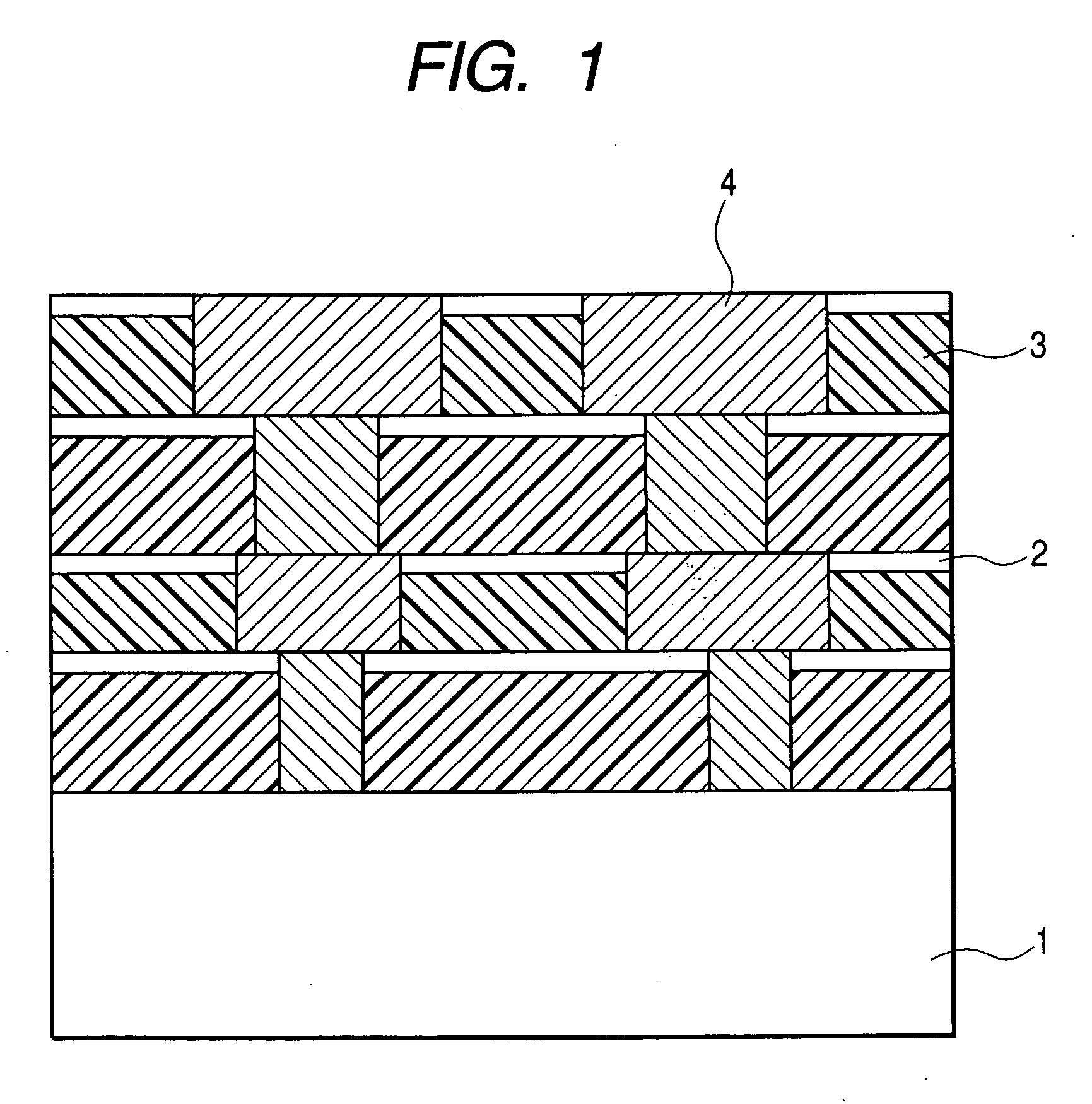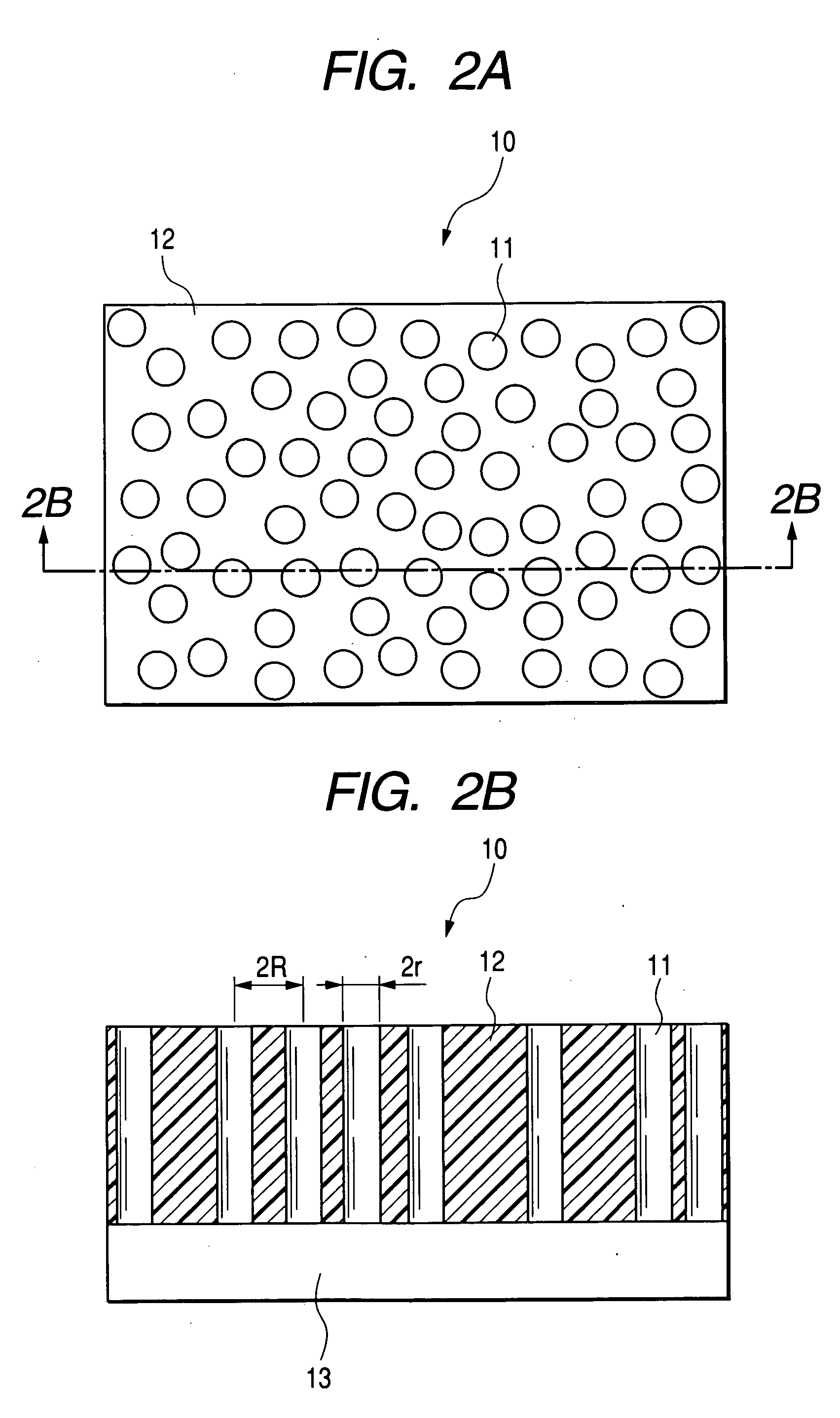Semiconductor device and method for manufacturing the same
a semiconductor device and structure technology, applied in the direction of recording information storage, maintaining head carrier alignment, instruments, etc., can solve the problems of increasing the cost of manufacturing semiconductor devices, affecting the quality of semiconductor devices, so as to achieve excellent chemical resistance and fine processing
- Summary
- Abstract
- Description
- Claims
- Application Information
AI Technical Summary
Benefits of technology
Problems solved by technology
Method used
Image
Examples
first example
[0082] The first example is an example of a semiconductor device wherein porous films having fine pores perpendicular to a substrate consisting mainly of silicon oxide are used as interlayer insulating layers, and wirings are formed by burying aluminum in the fine pores in the porous film. Here, an example of forming a via, which is a vertical wiring, is formed in the interlayer insulating layers will be described.
[0083] As described above, FIGS. 3A to 3D schematically show the manufacturing steps for forming interlayer insulating layers and metal wirings thereon. The manufacturing method will be described below referring to FIGS. 3A to 3D.
[0084] First, on a semiconductor substrate on which semiconductor elements such as MOSFET, wiring layers and element isolating regions (not shown) were formed, an aluminum-silicon mixture (mixed film) 20 containing 60 atomic % aluminum relative to the total quantity of aluminum and silicon as shown in FIG. 3A was formed using a magnetron sputter...
second example
[0094] The second example is an example of a semiconductor device wherein porous films having fine pores perpendicular to a substrate consisting mainly of silicon oxide are used as interlayer insulating layers, and metal wirings (via) are formed by burying Cu in the fine pores. Here, an example of forming a via, which is a vertical wiring, is formed in the interlayer insulating layers will be described.
[0095] As described above, FIGS. 4A to 4F schematically show the manufacturing steps for forming interlayer insulating layers and metal wirings thereon. The manufacturing method will be described below referring to FIGS. 4A to 4F.
[0096] First, on a semiconductor substrate 31 on which semiconductor elements such as MOSFET, wiring layers and element isolating regions (not shown) were formed, an aluminum-silicon mixture (mixed film) 30 containing 60 atomic % aluminum to the total quantity of aluminum and silicon as shown in FIG. 4A was formed using a magnetron sputtering method. As the...
third example
[0107] The third example is an example of a semiconductor device wherein porous films having fine pores perpendicular to a substrate consisting mainly of silicon oxide are used as interlayer insulating layers, and Cu was buried in the region after removing a part of the porous films as metal wirings.
[0108] As described above, FIGS. 5A to 5F schematically show the manufacturing steps for forming interlayer insulating layers and metal wirings thereon. The manufacturing method will be described below referring to FIGS. 5A to 5F.
[0109] First, on a semiconductor substrate on which semiconductor elements such as MOSFET, wiring layers and element isolating regions (not shown) were formed, an aluminum-silicon mixture (mixed film) 40 containing 60 atomic % aluminum to the total quantity of aluminum and silicon as shown in FIG. 5A was formed using a magnetron sputtering method. As the target, a circular aluminum-silicon mixed target of a diameter of 4 inches (101.6 mm) fabricated by mixing ...
PUM
 Login to View More
Login to View More Abstract
Description
Claims
Application Information
 Login to View More
Login to View More - R&D
- Intellectual Property
- Life Sciences
- Materials
- Tech Scout
- Unparalleled Data Quality
- Higher Quality Content
- 60% Fewer Hallucinations
Browse by: Latest US Patents, China's latest patents, Technical Efficacy Thesaurus, Application Domain, Technology Topic, Popular Technical Reports.
© 2025 PatSnap. All rights reserved.Legal|Privacy policy|Modern Slavery Act Transparency Statement|Sitemap|About US| Contact US: help@patsnap.com



